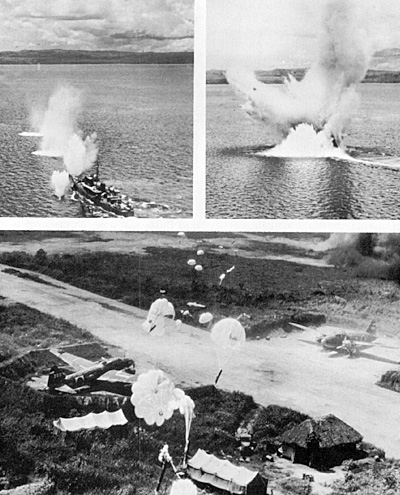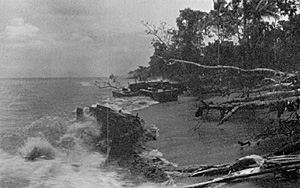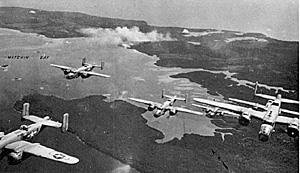 The Fifth Air Force
The Fifth Air Force
By October the Fifth Air Force in the Southwest Pacific Area was well situated to carry the fight against Rabaul.
Bombing Rabaul: Top: Japanese Corvette suffers direct hit off coast of New Britain. Bottom: Parachute bombs drop on Japanese=held Vunakanau airfield.
(This section is based on Craven and Cate, The Pacific: Guadalcanal to Saipan, pp- 251-55, 317-26; Kenney, General Kenney Reports, 313-20; Morison, Breaking the Bismarcks Barrier, pp. 275-88, 271-92; Thomas C. Wilds, "The Admiral Who Lost His Fleet," United States Naval Institute Proceedings, Vol. 77, No. it (November 1951); CTF 33 War Diary, Oct 43 entries; Southeast Area Naval Operations, Vol. III, Japanese Monogr NO. 50 (OCMH), PP. 5-11; Outline of Southeast Area Naval Air Operations, Pt. IV, Japanese Monogr No. 108 (OCMH), PP. 42-44.)
Nearly all its warplanes had been displaced to forward bases. Port Moresby, an outpost in 1942, was now a rear base. Dobodura was the main staging base for heavy bombers, and Nadzab was being readied as the main base for future operations. P-38's from New Guinea could stage through Kiriwina and escort the bombers all the way to Rabaul.
Rabaul was ripe for air attack. Transports, cargo ships, and smaller craft, together with some warships, crowded Simpson Harbor. Supply depots were fully stocked. Four all-weather airfields -- Lakunai, Vunakanau, Rapopo, and Tobera -- were in operation in and near Rabaul. (Lakunai had a sand and volcanic ash surface; the other three were concrete. Keravat field on the west coast of Gazelle Peninsula had never been used.)
Southwest Pacific aircraft had been harrying Rabaul with small raids since January 1942, but now the Allies were ready to attack this bastion on a large scale. General Kenney was ready for the first big attack on 12 October. All together, 349 planes took part: 87 heavy bombers, 114 B-25's, 12 Beatifighters, and 125 P-38's, plus some weather and photo reconnaissance planes -- or, as he put it, "Everything that I owned that was in commission, and could fly that far." (Kenney, General Kenney Reports P. 313.)
B-25's and Beaufighters made sweeps over Vunakanau, Rapopo, and Tobera while the heavy bombers struck at shipping. The Allies lost four planes and estimated a great deal of damage to Japanese aircraft and ships. Their estimates were somewhat exaggerated, especially those on shipping damage, but some Japanese planes were destroyed. The Japanese, taken by surprise and unable to send up fighters to intercept, later reported that this and later raids in October were "a great obstacle to the execution of operations." (Outline of Southeast Area Naval Air Operations, Pt. IV, Japanese Monogr No. 108 (OCMH), p. 44.)
Bad weather over New Guinea halted Kenney's operations against Rabaul for the next few days. The Japanese used the respite to send out attacks against Oro Bay on 15 and 17 October, and Finschhafen on 17 and 19 October. The Allied planes did not sit idle while Rabaul was inaccessible, but struck at Wewak on the 16th and again the next day.
Kenney planned and sent out another big raid against Rabaul on 18 October, but when the air armada was over the Solomon Sea the weather closed in. Fifty-four B-25's went on to Rabaul anyway. Kenney followed this attack with three successive daylight raids on 23, 24, and 25 October before the weather again imposed a delay, this time until the 29th, when B-24's and P-38's bombed Vunakanau.
 LCVPs on beach at Empress Augusta Bay damaged by rough, driving surf.
LCVPs on beach at Empress Augusta Bay damaged by rough, driving surf.
The weather intervened again, so that it was not until 2 November, the day after South Pacific forces landed at Empress Augusta Bay, that Southwest Pacific aircraft again struck at Rabaul. On that day seventy-five B-25's escorted by P-38's attacked and ran into the fiercest opposition the Fifth Air Force encountered during World War II. A large number of carrier planes. and pilots from the Combined Fleet at Truk had just been transferred to Rabaul, and they put up a stiff fight.
Although it is clear that these raids failed to wreak as much havoc at Rabaul as Kenney's fliers claimed, it is also clear that they caused a good deal of damage to aircraft and prevented the Japanese planes at Rabaul from undertaking any purely offensive missions. In short, the Southwest Pacific's air support for the Bougainville invasion, though not as devastating as was thought at the time, was effective.
Certainly American pilots, like the Japanese, and like soldiers and sailors on the ground and in ships, tended to exaggerate the damage they inflicted. But there were two important differences between American and Japanese claims.
- First, Japanese claims were wildly
exaggerated whereas American claims were
merely exaggerated.
Second, Japanese commanders apparently took the claims seriously, so that nonexistent victories often served as the bases for decision. On the other hand American commanders, taking human frailty into account, evaluated and usually scaled down claims so that decisions were normally based on more realistic estimates of damage.
Air Command, Solomons
General Twining's composite force, Air Command, Solomons, had been striking hard at the northern Solomons bases during the same period and for the same purpose-to knock out the Bougainville bases so that Wilkinson's convoys could sail past in safety. Twining's available air strength had been displaced forward to bases within range of south Bougainville targets. At the start of operations in October, Twining had 614 Army, Navy, Marine Corps, and Royal New Zealand Air Force planes. Of these, 264 fighters and 223 medium, dive, torpedo, and patrol bombers were at New Georgia and the Russells, and 127 heavy bombers and patrol planes were at Guadalcanal.
Ever since 1942 South Pacific planes had been battering at the Japanese bases at Kahili, the Shortlands, Ballale, Kieta, and Buka, and now the process was intensified in an effort to put them out of commission. (Kenney offered to include Buka in his attacks, but Halsey asked him to concentrate on Rabaul and leave Buka to Twining.)
 B-25's LEAVING BOUGAINVILLE after an attack on airfields and supply areas.
B-25's LEAVING BOUGAINVILLE after an attack on airfields and supply areas.
Starting on 18 October, Twining--whose high professional qualifications were matched by a physical appearance so striking that he looked like Hollywood's idea of a diplomat-- drove his interservice, international force hard in a continuous series of high-level, low-level, dive, glide, and torpedo bombing attacks and fighter sweeps, all made with escorting fighters from the four air services in the command. The primary mission was accomplished. The hard-hit enemy showed skill and determination in keeping his airfields in repair, but these qualities were not enough. By 1 November all his Bougainville airfields had been knocked out of commission, and the continuous attacks kept them that way.
The Japanese
Of Admiral Kusaka's 11th Air Fleet, a substantial portion was based at Rabaul in early October, the remainder in southern Bougainville. When Air Command, Solomons, intensified its operations, Kusaka withdrew his planes to Rabaul, and to avoid being completely destroyed by Kenney's heavy raids he frequently pulled his planes back to Kavieng in New Ireland. Despite these attacks Kusaka was usually able to maintain about two hundred planes in operating condition at Rabaul throughout October.
Now Admiral Koga, like the late Yamamato, decided to use his carrier planes jointly with the land-based planes of Kusaka's air fleet in an effort to improve the situation in the Southeast Area. As a result of the September decision to withdraw the main defensive perimeter, Koga developed a plan to cut the Allied lines of communication in the Southeast Area and so delay the Allies and buy time for the Japanese to build up the defenses along the main perimeter.
This plan, called Operation RO, was to be executed by the operational carrier air groups of the Combined Fleet, transferred from Truk to Rabaul, and by the 11th Air Fleet. Vice Adm. Tokusaburo Ozawa, commander of the 3d Fleet, and Kusaka would conduct the operation jointly from Rabaul. Koga decided on this course of action fully aware that his surface strength would be immobilized while his carrier planes were at Rabaul.
He had planned to transfer the planes in mid-October, but delayed the move because he received a false report that the U.S. Pacific Fleet was out against the Marshalls. On 20 October, now aware that Nimitz' forces were not moving against the Marshalls, Koga ordered the carrier planes dispatched. By the beginning of November, 173 carrier planes-- 82 fighters, 45 dive bombers, 40 torpedo bombers, and 6 patrol planes--had reached Rabaul to team with Kusaka's 200.
It was Ozawa's carrier pilots who gave Kenney's men such a hard fight on 2 November. Koga had first planned to deliver his main stroke against New Guinea but the increased tempo of Allied activity in the Solomons made him decide to strike in the Solomons.
Koga's decision to execute Operation RO was to have far-reaching results, results that were the precise opposite of what he expected. The transfer of the carrier planes coincided with the South Pacific's invasion of Bougainville.
More Invasion of Bougainville
- Decision To Bypass Rabaul
The General Plan
Air Operations in October
Forces and Tactical Plans
Preliminary Landings
Seizure of Empress Augusta Bay
Jumbo Map 15: Bougainville (monstrously slow: 794K)
Back to Table of Contents -- Operation Cartwheel
Back to World War Two: US Army List of Issues
Back to MagWeb Magazine List
© Copyright 2002 by Coalition Web, Inc.
This article appears in MagWeb (Magazine Web) on the Internet World Wide Web.
Other military history articles and gaming articles are available at http://www.magweb.com